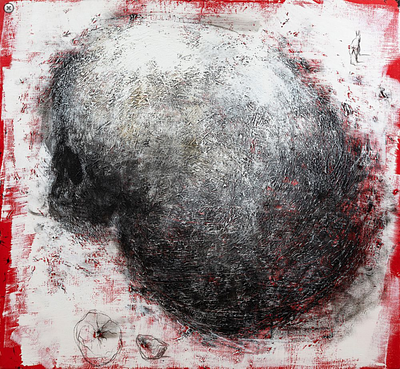ANTONI CLAVÉ I SANMARTÍ(Barcelona, 1913 - Saint Tropez, France, 2005). Untitled. Mixed media and collage on cardboard. Signed in the lower right corne
Lot 100
About Seller
Setdart Auction House
Carrer Aragó 346
Barcelona
Spain
Setdart Subastas was born in 2004 and is currently the first online art auction in Spain with solidity, prestige and reliability guaranteed by our more than 60,000 users. Setdart has a young, dynamic and enterprising team ready to successfully manage the purchase and sale of art works through custom...Read more
Categories
Estimate:
EUR€3,000 - EUR€3,500
$3,125 - $3,645.83
Absentee vs Live bid
Two ways to bid:
- Leave a max absentee bid and the platform will bid on your behalf up to your maximum bid during the live auction.
- Bid live during the auction and your bids will be submitted real-time to the auctioneer.
Bid Increments
| Price | Bid Increment |
|---|---|
| EUR€0 | EUR€10 |
| EUR€200 | EUR€25 |
| EUR€500 | EUR€50 |
| EUR€1,000 | EUR€100 |
| EUR€3,000 | EUR€200 |
| EUR€5,000 | EUR€500 |
| EUR€10,000 | EUR€1,000 |
| EUR€20,000 | EUR€2,000 |
| EUR€50,000 | EUR€5,000 |
About Auction
By Setdart Auction House
Oct 19, 2021
Set Reminder
2021-10-19 08:00:00
2021-10-19 08:00:00
America/New_York
Bidsquare
Bidsquare : CONTEMPORARY ART
https://www.bidsquare.com/auctions/setdart-auction-house/contemporary-art-7701
Setdart Auction House sofia@setdart.com
Setdart Auction House sofia@setdart.com
- Lot Description
ANTONI CLAVÉ I SANMARTÍ(Barcelona, 1913 - Saint Tropez, France, 2005). Untitled. Mixed media and collage on cardboard. Signed in the lower right corner. Size: 34,5 x 24,5 cm; 62 x 52 cm (frame). Antoni Clavé was a multifaceted artist who synthesised figuration with abstraction, the effects of trompe-l'oeil with the strength of matter, the incorporation of the object with the gestural stroke and the sources of tradition with the concerns of the avant-garde. He went into exile in Paris and became friends with Pablo Picasso, which led him to immerse himself in the world of collage and assemblage and to become a researcher of all kinds of textures and materials, which he used to create his works, as in the case of the one we are auctioning here. Antoni Clavé is one of the most important figures in Spanish contemporary art. Trained at the San Jordi School of Fine Arts in Barcelona, Clavé initially devoted himself to advertising graphics, illustration and the decorative arts. In 1936 he took an active part in the Civil War, joining the Republican ranks, which led him to go into exile in France at the end of the war. That same year, 1939, he exhibited the drawings he had made on the battlefields. He settled in Paris, where he met Vuillard, Bonnard and Picasso. From this period onwards, Clavé began to develop a work marked by a different, less classical style. During this period his figures gradually lost their precision and form, giving way to the lines and a personal range of colours and textures that were to become the main features of his works from that time onwards. He was already enjoying great international prestige at the time when he began to be recognised in Spain, after his exhibition at the Sala Gaspar in Barcelona in 1956. In 1952 he made the sets for the film "Hans Christian Andersen", by Charles Vidor, and was nominated for an Oscar. In 1954 he gave up decorating to devote himself to painting. In the 1960s he painted a tribute to El Greco, and his painting at this time reveals the influences of that master, as well as those of the Baroque painters. Of particular relevance is the theme of the knight with his hand on his chest, a reference that would be repeated in Clavé's future works. This period is characterised by the definitive transition to abstraction. In the 1970s Clavé's work continued to evolve, using various techniques such as collage, and inventing new ones such as "papier froissé", the result of a chance use of aerosol on crumpled paper. In 1978, the Musée National d'Art Moderne in Paris, now the Centre Georges Pompidou, devoted a retrospective to him that made him one of the most prestigious artists of his generation. In the 1980s he dedicated a series of works to Picasso under the title "To Don Pablo". His latest works are characterised by the recreation of textures within abstraction, with a profuse use of papier froissé. He was awarded prizes at the Hallimark in New York in 1948, at the Venice Biennial in 1954 and at the Tokyo International Biennial in 1957. In 1984 the Spanish state recognised his artistic value with the exhibition of more than one hundred of his works in the Spanish pavilion at the Venice Biennale. That same year he was awarded the Gold Medal of the Generalitat de Catalunya. Clavé's work can be found, among many others, in the Bilbao Fine Arts Museum, the Tate Gallery, the Modern Art Museum in Paris and Tokyo, the British Museum and the Reina Sofía Museum in Madrid.
- Shipping Info
-
In-house shipping available. Please inquire at admin@setdart.com.
-
- Buyer's Premium



 EUR
EUR CAD
CAD AUD
AUD GBP
GBP MXN
MXN HKD
HKD CNY
CNY MYR
MYR SEK
SEK SGD
SGD CHF
CHF THB
THB















